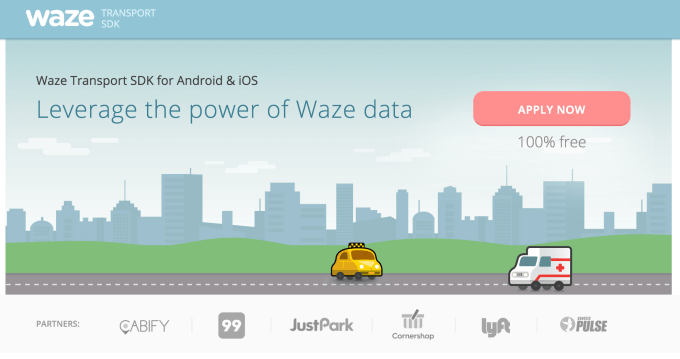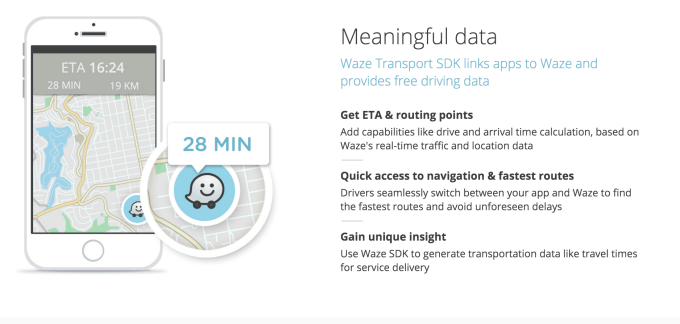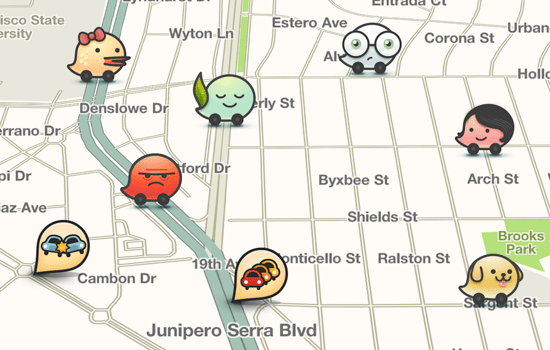Waze, the popular Google-owned navigation app that helps drivers route around traffic and alerts them to other road hazards in real-time, is today announcing partnerships with half a dozen companies in the on-demand and transportation space worldwide, including Lyft, who will integrate Waze software into their own applications to provide routing and guidance.
This, in turn will feed more data back into Waze’s mapping application, allowing the company to provide more accurate and updated data to its own customers.
In addition to Lyft, partners include other ride-sharing, dispatch, parking, and food delivery services in countries outside the U.S.
The full list at launch includes Genesis Group (U.K. emergency dispatch technology company), JustPark Parking (parking company in the U.K.), Cabify (ride-sharing in Spain, Chile, Peru, Mexico, and Colombia), 99Taxis (ride-sharing in Brazil), and Cornershop (food-delivery service in Mexico and Chile.)

These partners will use the Waze Transport SDK, as this new development kit is called, which will allow them to offer Waze’s driving data in their applications.
For example, Waze will update routes if drivers are using it to navigate, but Lyft says it won’t do in-app step-by-step instructions. However, with Lyft running in the background, it can send new pickup data to drivers and Waze will automatically update the route to the new destination. The functionality around route updating will be used more for Lyft Line matches than avoiding incidents, the company says.
For a partner like Lyft, this is an advantage in terms of driver and passenger safety – updating routes before was handled manually, which involves fiddling with the phone. Waze tells us that this is a critical pain point for many of its partner-platform drivers, who currently toggle between windows on their phone to use a different navigation service besides their employers’.
Plus, it also offers a service like Lyft a competitive advantage, as drivers who don’t get stuck in traffic can complete their fares more quickly, offer passengers an improved experience – both of which can help to impact Lyft’s and others’ bottom line in terms of more completed rides and repeat business.

Meanwhile, for partners in the emergency dispatch space, Waze notes that shaving time off their response rate may actually save lives.
According to Waze’s website, the Transport SDK will offer partners navigation and routing, as well as ETA calculations.
These ETA calculations are useful not only for ride-sharing companies, but also for delivery services who want to alert their customers when their order arrives, whether that’s dinner from a restaurant, groceries or something else entirely.
Partners will also be able to tap into travel data generated through the platform, which will help them gain a better understanding of travel time for service delivery, for example. This could aid businesses like ride-sharing companies and delivery services, who rely on data to improve their own routing systems and software.
Waze says the Transport SDK is customizable, meaning its partners can choose how to take advantage of the features provided. For example, in Lyft’s case, the company is using the software to update routes in real-time and let drivers move between apps more seamlessly.
“At Lyft, we are always focused on bringing the best possible experience to our passengers and drivers,” said Oliver Hsiang, VP of Business Development at Lyft in a statement. “As the first and only ridesharing company to incorporate Waze’s latest advancements, we can make routing and rides even more efficient, which benefits everyone on the Lyft platform.”
The news is part of a larger trend involving the collection of smartphone data in the transportation and delivery space. For instance, it comes on the heels of Uber’s recent announcement that it will now begin to use data collected on drivers’ phones in order to track things like speeding and irresponsible driving.
For Waze, there’s a great advantage to offering its real-time navigation software to these partners, as it immediately increases the number of drivers using its platform, and therefore, feeding it more data on real-time traffic conditions. Lyft, for instance, has over 100,000 active drivers; 99Taxis boasts of over 100,000 taxis using its app, as well; and JustPark has some 500,000 users of its site and app – to give you an idea of scale.
“Waze and our new partners share a common mission to combine strengths and share knowledge to provide a better experience for our respective users,” said Amir Mirzaee, head of Business Development at Waze. “This is big news for the Waze community as well. The SDK launch effectively adds hundreds of thousands of drivers on partner platforms to the 50 million users already contributing data to our map, greatly amplifying the amount of insight we have.”
This is not Waze’s only effort to translate its consumer-facing mapping and navigation app into an enterprise platform. The company in the past has made its data available to over 55 municipalities through its Waze Connected Citizens program, and it has over 135 broadcast partners who use Waze’s data to power their traffic reporting, the company notes.
Waze says this SDK has been in beta testing with several partners over the past month, and will roll out to all partners over the next few weeks.
Post updated, 1/26/16, 3:30 PM ET, to clarify how Lyft will use Waze data in Lyft Line.
